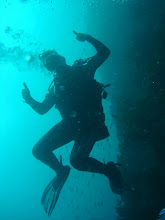The first thing I noticed as we cruised nearer the island was a brilliant flash of red against the pastel blue and pine green of sea and forest. At that distance, I didn't know what it was, but as we edged closer I made it out to be the giant gateway known as the O-Torii, a symbolic structure marking the transition from the profane to the sacred. It's vermilion shades striking against the backdrop of the forested hillside, it was an impressive and imposing sight.
As we stepped ashore, we immediately had to negotiate our passage through herds of wild but tame deer that roam freely here. In the native Shinto religion, deer are considered messengers of the gods, and holy as they are they harbored no shame in haranguing the tourists for a free lunch. Winding our way through the throngs of deer and tourists, we passed myriad temples and wandered along traditional Japanese lanes, all dotted with a plethora of restaurants and craft shops, some tasteful and others tacky. Everywhere you looked there were stone statues and wooden shrines, with the fragrant aroma of burning incense invoking the memory of ancient ancestors.
The main draw on the island is the Itsukushima Shrine. The present structure, built in the mid sixteenth century and recently recognised as a U.N.E.S.C.O. World Heritage Site, is considered so pure that no human can die or be born near the shrine. Pregnant women or the very elderly are banished to the mainland in order to retain the shrine's purity...a little harsh perhaps, but all in the name of tradition. The shrine itself is built on piers, and when the tide is high it appears to be levitating over the water. As the island itself is considered sacred, commoners were not allowed to step foot on it's shores, but were permitted to worship at the shrine due to it being a separate entity from the island. It is a beautiful and evocative place, and as I walked around I tried to imagine it without the tourists. Back in it's heyday, I am sure this was a very spiritual experience for the common pilgrims, coming to worship at the shrine dedicated to Susano-o no Mikoto, Shinto deity of seas and storms.
A short hike from behind the powerful yet intricate architecture of the shrine takes you into the scenic hills of Momijidani Park. Awash with colorful maples and azalea, the trails were a cool escape from the summer heat, and afforded great views over the towering pagodas, colorful temples and the pretty coastline. Passing by lazy groups of shade seeking deer, we criss-crossed small streams and trickling waterfalls, and spent some time soaking up the tranquility in the ornate tea gardens.

Luckily, very few tourists had the energy in the heat to make it up to this secluded spot, so we had the serenity and solace for which these stunning ponds, complete with their coy carp and twisted bonsai trees, were designed for. It was magical, and hinted at a golden era of Japanese history and tradition.
As our day came to an end, we took a final look at the colossal O-Torii gateway, now looming even larger and more spectacular as the sun set and the tide receded, and as we departed this mystical island by boat, llike so many tourists and pilgrims before us, we vowed to return.





